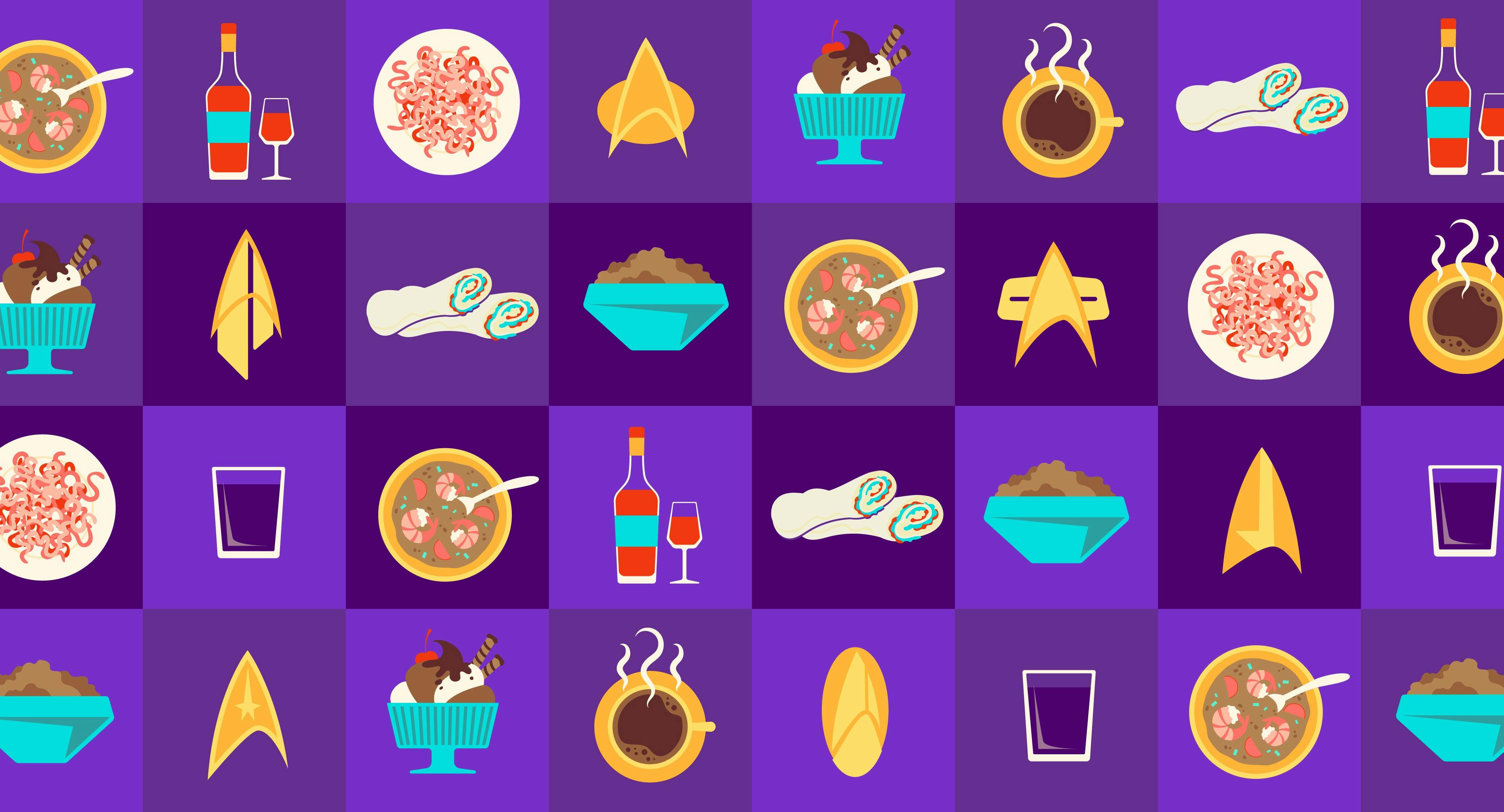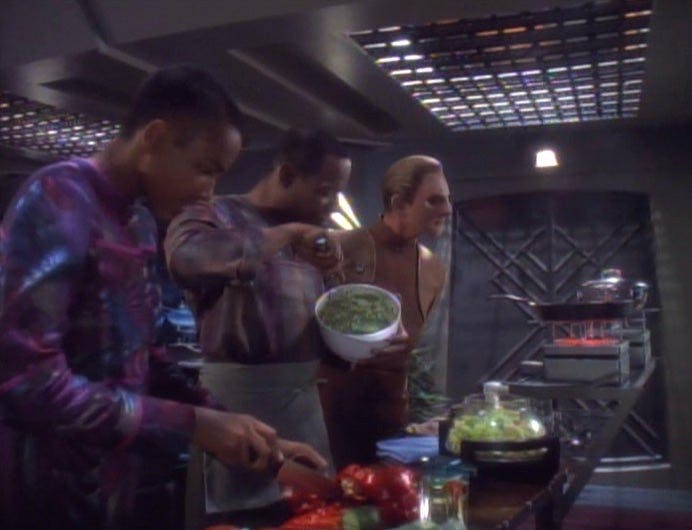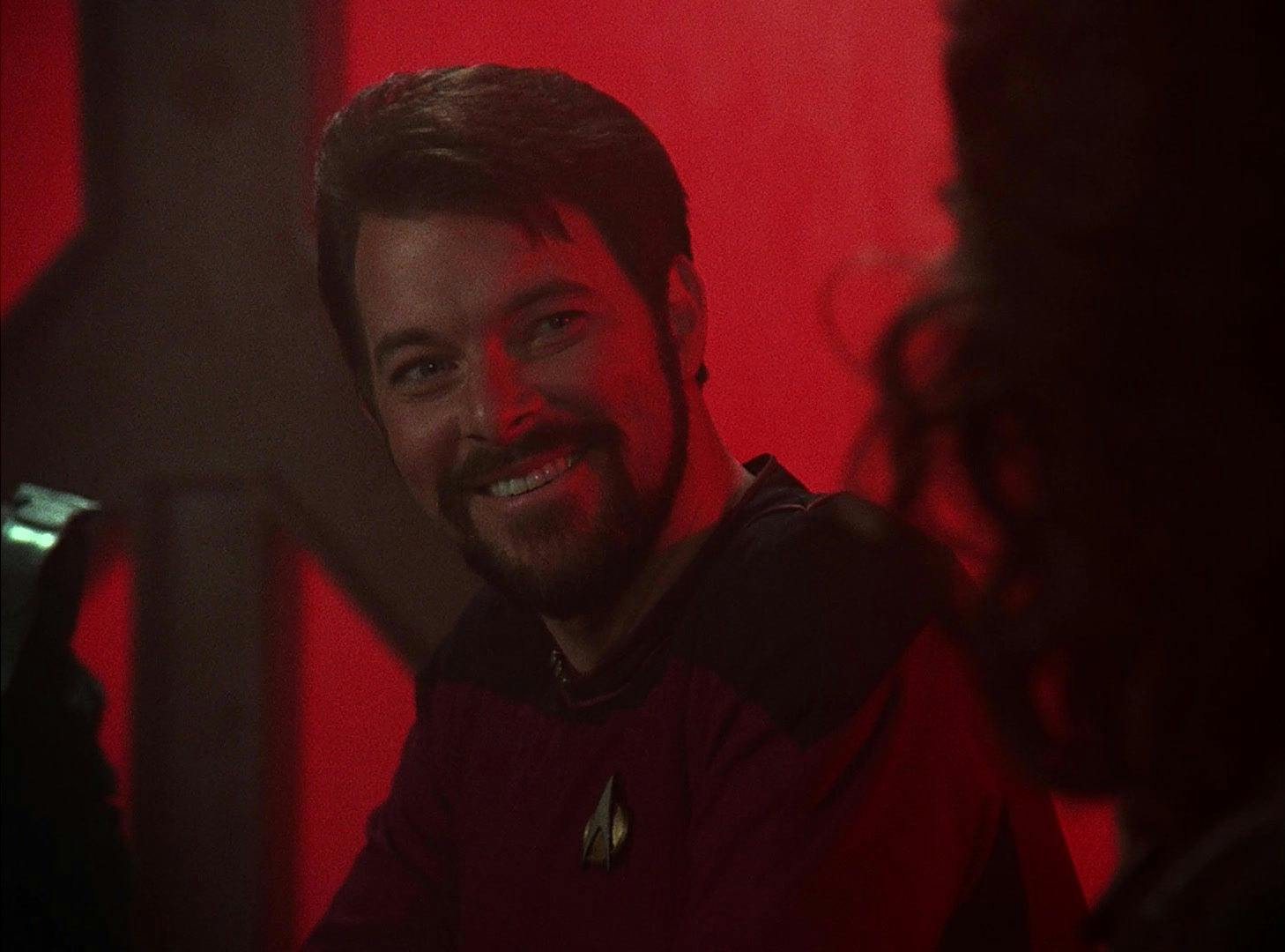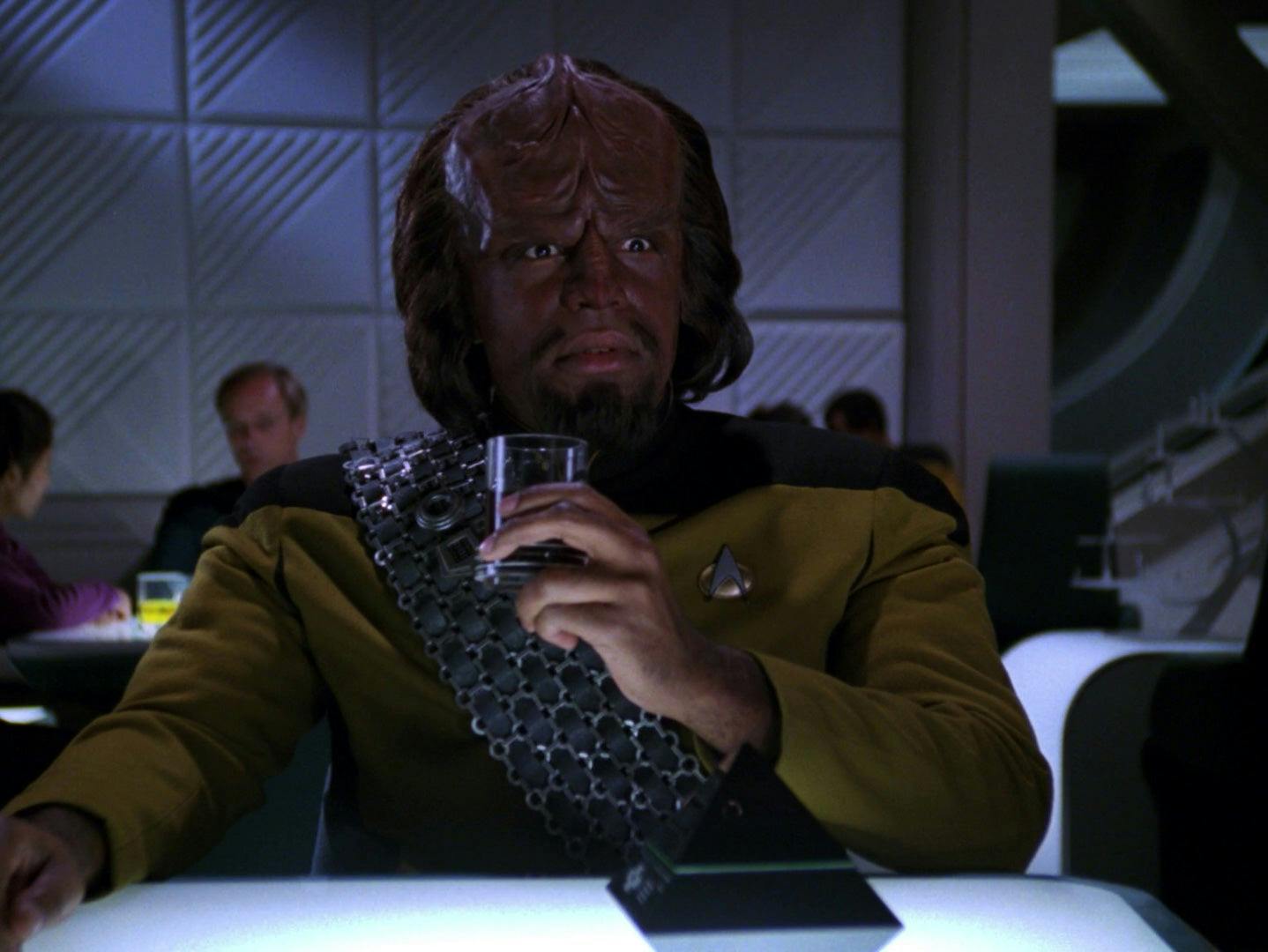Published May 19, 2022
Edible Star Trek: How Food and Drink Tell Our Starship Stories
Even in a universe with replicators, nothing beats a homemade meal.

StarTrek.com
As a food writer and Star Trek enthusiast, I always take note whenever our favorite starship - and space station - bound characters interact with each other in the midst of “edible Star Trek” scenes. The writer and director's decision to include a meal or a drink in many episodes is always deliberate. It’s a familiar way to tell an unfamiliar space story that remains accessible to modern viewers. While we don’t all work on starships, all of us eat and drink. Gastronomic scenes also do robust narrative work that add depth to these starship stories and characters. Across various shows in the Star Trek universe, food and drink-focused scenes work on a deeper metaphorical level for building—and rebuilding—interpersonal connections, wielding power, and embracing both internal and external journeys of exploration.
Food as Connection

StarTrek.com
Like Counselor Troi and chocolate, once you start to consider Star Trek through the lens of food and drink, it’s hard to stop. Of course, we begin with Sisko. In addition to his roles as captain and Emissary on Star Trek: Deep Space Nine, Captain Benjamin Sisko also serves as one of the best cooks in the greater Star Trek universe (sorry Neelix). In a future with food replicators, a home-cooked meal demonstrates deep affection, which is key to Sisko’s character especially as he faces down the challenges of the Dominion War. Sans kitchen, he creates delicious meals in his quarters, constructing dishes like a jazz musician improvises a tune. Not surprisingly, Sisko’s father still runs a replicator-free Creole restaurant in New Orleans, Earth. For the Siskos, real food means love: it helps us to connect and stay connected.
The newest Star Trek shows continue to link food and affection. In season 4 of Star Trek: Discovery, President of Ni’Var T’Rina has salt tea from Kaminar delivered to Saru during a meeting about expanding the Federation. Saru is both delighted and intrigued.
He responds later with a gift of his own: a specimen of Fredalia from his planet, who’s flower provides the unique flavor to a floral tea of Kaminar. These food-focused opening moves on the chessboard of feelings leads to a satisfying relationship arc for these characters. T’Rina and Saru’s relationship develops slowly but surely for the remainder of the season, including the careful, deliberate decision over whether or not to accept a dinner invitation - awkwardly adorable.
When time is of the essence, however, as in the first season of Star Trek: Picard, edible Star Trek scenes function both as powerful “narrative propellant” for the story as well as connective tissue between characters. When “JL” walks out of the past and up toward Raffi Musiker’s desert trailer, she only lowers her weapon when she confirms he brought her favorite vintage. Clearly, they have shared Château Picard wines in the past; a flashback is unnecessary. Only through his wine peace offering was she even willing to listen to him. Picard hoped that this apology gift would soften her righteous anger and begin to repair their relationship because he needed her brilliant help. His effort to reconnect with her through a special bottle makes it emotionally visible how this wine links these two characters in the past and the present. Picard’s wine bottle gamble works: he has begun to repair his relationship with Raffi, and in turn she agrees to help him on his mission. And, we’re off!
Edible Star Trek scenes even connect terrestrial fans to famous foods that starship travelers will encounter in the future. Beginning with Ensign Ro in Star Trek: The Next Generation and Colonel Kira in Star Trek: Deep Space Nine and then jumping 930+ years into the future with Adira Tal in Star Trek: Discovery, consistent references to spicy Bajoran hasperat across space and time in the Star Trek universe satisfy fans’ taste for canonical consistency and continuity.
Food as Power

StarTrek.com
In addition to establishing and re-establishing interpersonal connections between characters, scenes featuring food and drink also serve as metaphors for aggressive power plays, especially with Klingons and Terrans. In Star Trek: The Next Generation’s “A Matter of Honor,” Commander Riker prepares for his officer exchange with a Klingon vessel by consuming a wide range of Klingon fare, but replicator-generated gagh is not the same as the writhing dish of serpent worms on offer in the I.K.S. Pagh dining hall. When First Officer Riker sighs and notes that his food is still moving, Second Officer Klag declares, “Gagh is always best when served live.”
Riker’s hesitation inspires hearty Klingon laughter, but it is soon followed by some surprisingly vulnerable conversation about feelings and family where Klag says that Klingons do not express feeling the way humans do and, frankly, “We would not know how.” Riker impresses his Klingon fellow officers by saying, “Yesterday, I did not know how to eat gagh,” while dramatically chewing and swallowing a large bite. This food fearlessness helps his Klingon crew mates to see him in a new way. Riker survives the Klingon cuisine hazing and earns some respect from his skeptical Klingon crew.
Star Trek: Discovery also presents food as a way to wield power, especially in the violent Terran Mirror Universe. Fans likely know about Earth-based luxury foods such as black truffles, oysters, and caviar. Therefore, we recognize how Mirror Universe Emperor Georgiou’s luxury cannibalistic diet of Kelpian flesh channels the Terran values of cultivating fear, exerting power, and performing violence constantly, from the throne room to the plate.
Making polite dinner conversation with the deadly Terran Emperor, undercover Prime Universe Michael Burnham says, “The food is delicious, as always.” “No one prepares Kelpian like the imperial chef,” remarks Emperor Georgiou as Burnham freezes. “Here…have my ganglia,” says the Emperor, “You deserve a treat.” As she swallows the Kelpian threat ganglia from the chopsticks of Emperor Georgiou, horrified Burnham plays this table very carefully. It’s a testament to Emperor Georgiou’s growth arc across her time in our Prime Universe that, upon her return to the Terran universe during her “weighing” via the Guardian of Forever, she takes Kelpian off the menu.
Food as Exploration

StarTrek.com
Many of us explore new cuisines while traveling to unfamiliar places. What if you’ve been trapped in a space prison for as long as you remember and have only eaten the same prison rations since forever? How do you order something new from the replicator if you only know one dish? On Star Trek: Prodigy, Rok-Tahk doesn’t yet know how to request new foods from the replicator on the Protostar because the only type of food she knows are the rations she grew up eating - a brown, indistinct goo served in a bowl. The younger target audience instinctively understands that knowing only one kind of food indicates limited life experience.
New Tastes and Experiences Help Us Grow

StarTrek.com
One of the most beloved Star Trek scenes that uses an openness to new food and drink as a signal of personal growth and internal exploration occurs in Star Trek: The Next Generation when Guinan introduces Lieutenant Worf to a warrior’s drink one fateful day in 10 Forward. After dismissing her suggestions about getting to know other members of the crew on a personal level, Worf skeptically tries Guinan’s offer of a human beverage called “prune juice.” The look of surprise and pleasure on his face suggests that he realizes he might have more to learn from human culture than he may have initially thought. Perhaps today is a good day to open one’s Klingon mind.
Ten Forward, Quark’s, and Edible Star Trek Watering Holes: An Appreciation

StarTrek.com
Without the space of 10 Forward, Guinan would have encountered more barriers to teaching Worf about open mindedness through a glass of prune juice. Indeed, the casual eating and drinking spaces of 10 Forward, Quark’s, the lounge on Discovery, and all the Star Trek social spaces allow for interpersonal connection that happens more easily than in work areas like Engineering or the bridge. Guinan joined Star Trek: The Next Generation in the show’s second season, and the rest is edible Star Trek history. Can you imagine seven TNG seasons without the connecting space of the ship’s bar? Where would Scotty have secured the green Aldebaran whiskey in “Relics?” 10 Forward is key to edible Star Trek storytelling.
Quark’s in Star Trek: Deep Space Nine has more of a profit motive than the starship-based bars that offer free synthehol and replicated food, which makes Quark's the perfect non-Federation bar in this, the grittiest of all the Star Trek shows. With a dart board, gaming tables, and a Ferengi behind the bar, it’s the perfect hub for socializing on a reclaimed Cardassian mining outpost. In the premiere episode of DS9, Sisko clearly understands how important social spaces will be for making the Cardassian outpost Terok Nor into a welcoming space station run by Starfleet. With a bit of manipulation, Sisko “helps" a reluctant, fearful Quark understand how vital Quark’s will be to the success of their DS9 project. Sisko knows how important connecting with others will be to building community on this space station. Ergo, Quark’s.
Edible Star Trek scenes across the Starfleet universe help tell our favorite starship stories and serve as a flavorful shorthand for moving the characters and stories forward, particularly by signaling the importance of strengthening interpersonal connections, wielding power, and embracing journeys of exploration. Current Star Trek creatives understand how much narrative mileage they can get from food and drink-focused vignettes so they keep inventing ways to incorporate fresh edible Star Trek scenes, including the addition of a bar on the U.S.S. Cerritos in Star Trek: Lower Decks. With a couple of olives on a toothpick jauntily tucked into a Starfleet delta shield, the logo for this newest social space promises that the Star Trek universe will continue to prioritize gastronomic scenes and locations that help tell great stories.
Writer R. A. Duchak (she/her) was in utero when Armstrong and Aldrin walked on the moon, and she’s been a space nerd ever since. She has worked as a radio host and producer, university writing instructor, webmaster, editor, and Outward Bound instructor. You can find her on Twitter @ccfoodie.
Star Trek: Picard streams exclusively on Paramount+ in the U.S. and is distributed concurrently by Paramount Global Distribution Group on Amazon Prime Video in more than 200 countries and territories. In Canada, it airs on Bell Media’s CTV Sci-Fi Channel and streams on Crave.
Star Trek: Discovery currently streams exclusively on Paramount+ in the U.S. Internationally, the series is available on Paramount+ in Australia, Latin America and the Nordics, and on Pluto TV in Austria, France, Germany, Italy, Spain, Switzerland and the United Kingdom on the Pluto TV Sci-Fi channel. In Canada, it airs on Bell Media’s CTV Sci-Fi Channel and streams on Crave. Star Trek: Discovery is distributed by Paramount Global Distribution Group.
